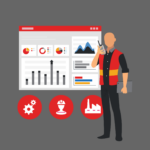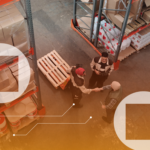
In today’s fast-paced, competitive, and convenience-driven world, supply chains are essential in meeting the demands of a growing global population and adapting to changing consumer preferences. Among these supply chains, three components stand out: the Fresh Cut, Cold Chain, and Grocery supply chains.
Each component plays an essential role in shaping the industry and is a critical part of the food chain. Together, they form the backbone of the food industry—seamlessly connecting products, processors, distributors, and retailers. Efficiently managing the lifecycle of perishable goods is essential for optimizing supply chain operations, reducing waste, ensuring product quality, and meeting customer demand.
To meet these expectations, supply chains must possess the capability to streamline and optimize their operations in today’s modern food industry. Let’s delve deeper into each supply chain to understand its function, challenges, and innovative solutions for your business to enhance your operations within these supply chains.
What are they?
Fresh cut, cold chain, and grocery supply chains are all specialized supply chain systems designed to manage, and provide the healthiest, freshest, and most sustainably sourced food.
Fresh-cut supply chain: A supply chain primarily dealing with pre-packaged, ready-to-eat fruits, vegetables, and salads. This helps to save consumers time and effort in meal preparation and prioritizes health and convenience. As practical as these products may be, they have a limited shelf life due to their perishable nature.
Cold chain supply chain: A supply chain involving transportation, delivery, and storage of controlled temperature-sensitive goods such as meat or seafood, dairy products, and pharmaceuticals (typically refrigerated or frozen). To ensure these goods meet regulatory standards, it is crucial to preserve the quality and safety of perishable foods through strict temperature regulations.
Grocery supply chain: A supply chain incorporating the process of sourcing, distributing, and delivering a wide range of food and non-food products. From manufacturers to retail stores, supermarkets, and as of recent years online grocery platforms. Ensuring the availability of essential goods to customers includes everything from inventory management to last-mile delivery.
How can your business optimize your operation for them?
It’s important for businesses to regularly review and update strategies to ensure they are gaining the momentum they need to continue growing, adapt to consumer preferences, and stay competitive. By prioritizing a few of these strategies, your business can optimize your operations.
Fresh-cut supply chain optimization strategies: To provide the freshest and safest products, they must be examined through every stage of their shelf life. So, having accurate demand forecasting is crucial. Not only will it help to minimize over or underproduction, but it can help reduce waste and ensure product availability.
A few ways this can be achieved is through utilizing supply chain visibility in real-time tracking and monitoring systems. These systems enhance the review of each stage by regularly inspecting and sorting products to remove damaged or spoiled items. Throughout the review, it’s vital to maintain an exact temperature control to preserve the product’s freshness.
This will help to ensure quality products are distributed. As well as the potential of advancing the packaging of products to ensure it can maintain and even extend the product’s shelf life to prevent contamination.
Cold chain supply chain optimization strategies: Throughout storage, transportation, to delivery, products within the cold chain supply must be heavily monitored to prevent product spoilage and guarantee the quality of the product. A way to optimize your monitorization is by implementing technology to track real-time visibility of product conditions. This will enhance your quality control measures for inspections and documentation.
To help reduce costs, securing strict temperature control throughout each process must be maintained. Utilizing visibility of route planning, energy-efficient refrigeration, and storage solutions through software systems can reduce costs and transportation time as well. Staying up to date on these types of regulations and standards related to cold storage and logistics will help avoid compliance issues and provide sustainability.
Grocery supply chain optimization strategies: COVID-19 heightened the importance of the grocery supply chain, as the world experienced delays and disruptions which led to multiple supply shortages and logistics challenges. Along with the increasing use of E-commerce and online grocery shopping. Which drove grocery chains to invest in technology and automation to meet evolving customer expectations.
Ensuring you are optimizing the advancement of technology by using analytics, such as ABC analytics to prioritize products, and data to forecast demand accurately will reduce the risk of over or underordering. Utilizing technology and automation streamlines best warehouse practices, and operations, helps reduce transportation and delivery costs, and creates efficient inventory management techniques. In addition to adapting to new sustainability initiatives to help reduce waste and enhance eco-friendly transportation options.
As customer expectations evolve, the supply chain industry must adapt and utilize technology for optimization to enhance these strategies and overall efficiency to ensure product quality and safety. It is crucial to explore how to tailor these supply chain systems to meet the unique needs of your organization, as each of these supply chain systems has a multifaceted impact on the economy’s stability and growth.
At SIMOS Solutions we provide a performance-based staffing solution that can help optimize your cold chain, fresh cut, and grocery operation. Our custom solutions are built on driving performance, so you only pay for the work completed and can flex to help you meet changing demands.



